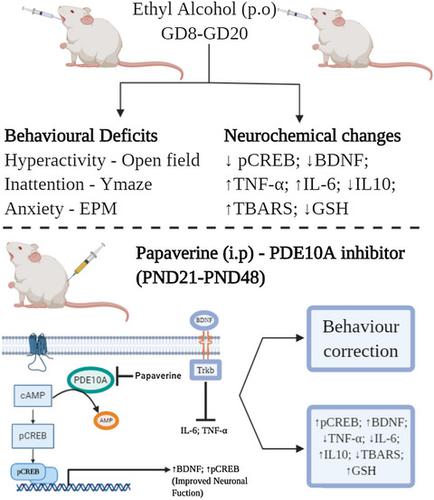当前位置:
X-MOL 学术
›
Int. J. Dev. Neurosci.
›
论文详情
Our official English website, www.x-mol.net, welcomes your
feedback! (Note: you will need to create a separate account there.)
Papaverine ameliorates prenatal alcohol‐induced experimental attention deficit hyperactivity disorder by regulating neuronal function, inflammation, and oxidative stress
International Journal of Developmental Neuroscience ( IF 1.7 ) Pub Date : 2020-12-18 , DOI: 10.1002/jdn.10076 Niti Sharma 1 , Neerupma Dhiman 2 , Lalit K Golani 3 , Bhupesh Sharma 1, 4
International Journal of Developmental Neuroscience ( IF 1.7 ) Pub Date : 2020-12-18 , DOI: 10.1002/jdn.10076 Niti Sharma 1 , Neerupma Dhiman 2 , Lalit K Golani 3 , Bhupesh Sharma 1, 4
Affiliation

|
Attention deficit hyperactivity disorder (ADHD) is a neurodevelopmental disorder with complex aetiology and phenotypes. Phosphodiesterase-10A (PDE10A) has been shown to provide benefits in various brain conditions. We investigated the role of papaverine, a selective PDE10A inhibitor on core phenotypes in prenatal alcohol exposure (PAE) model of ADHD. In order to identify probable mechanisms involved, the effects on several protein markers of neuronal function such as, neuronal survival-BDNF, neuronal transcription factor-pCREB, brain inflammation (IL-6, IL-10 and TNF-α) and brain oxidative stress (TBARS and GSH) were studied in frontal cortex, cerebellum and striatum. PAE resulting hyper-locomotion, inattention and anxiety were studies by use of open-field, y-maze and elevated plus maze, respectively. Administration of papaverine (15/30 mg.kg-1 ) to PAE group of animals resulted in amelioration of hyperactivity, inattention, and anxiety. Also, papaverine resulted in significant increase of the levels in BDNF, pCREB, IL-10 and GSH along with significant decrease of TNF-α, IL-6 and TBARS in different brain areas of PAE group. Papaverine, a selective PDE10A inhibitor rectified behavioural phenotypes associated with ADHD, possibly by altering protein markers associated with neuronal survival, neuronal transcription factor, brain inflammation, and brain oxidative stress. Implicating PDE10A as a possible target for furthering our understanding of ADHD phenotypes.
中文翻译:

罂粟碱通过调节神经元功能、炎症和氧化应激改善产前酒精引起的实验性注意力缺陷多动障碍
注意缺陷多动障碍(ADHD)是一种具有复杂病因和表型的神经发育障碍。磷酸二酯酶 10A (PDE10A) 已被证明对各种大脑疾病都有益处。我们研究了罂粟碱(一种选择性 PDE10A 抑制剂)对 ADHD 产前酒精暴露 (PAE) 模型核心表型的作用。为了确定所涉及的可能机制,研究对神经元功能的几种蛋白质标志物的影响,例如神经元存活 - BDNF、神经元转录因子 - pCREB、脑炎症(IL-6、IL-10 和 TNF-α)和脑氧化应激(TBARS 和 GSH)在额叶皮层、小脑和纹状体中进行了研究。分别使用旷场、Y 型迷宫和高架十字迷宫来研究 PAE 导致的过度运动、注意力不集中和焦虑。向PAE组动物施用罂粟碱(15/30mg.kg-1)导致多动、注意力不集中和焦虑的改善。此外,罂粟碱还导致 PAE 组不同脑区 BDNF、pCREB、IL-10 和 GSH 水平显着升高,同时 TNF-α、IL-6 和 TBARS 水平显着降低。罂粟碱是一种选择性 PDE10A 抑制剂,可能通过改变与神经元存活、神经元转录因子、脑炎症和脑氧化应激相关的蛋白质标记物来纠正与 ADHD 相关的行为表型。将 PDE10A 视为进一步了解 ADHD 表型的可能目标。
更新日期:2020-12-18
中文翻译:

罂粟碱通过调节神经元功能、炎症和氧化应激改善产前酒精引起的实验性注意力缺陷多动障碍
注意缺陷多动障碍(ADHD)是一种具有复杂病因和表型的神经发育障碍。磷酸二酯酶 10A (PDE10A) 已被证明对各种大脑疾病都有益处。我们研究了罂粟碱(一种选择性 PDE10A 抑制剂)对 ADHD 产前酒精暴露 (PAE) 模型核心表型的作用。为了确定所涉及的可能机制,研究对神经元功能的几种蛋白质标志物的影响,例如神经元存活 - BDNF、神经元转录因子 - pCREB、脑炎症(IL-6、IL-10 和 TNF-α)和脑氧化应激(TBARS 和 GSH)在额叶皮层、小脑和纹状体中进行了研究。分别使用旷场、Y 型迷宫和高架十字迷宫来研究 PAE 导致的过度运动、注意力不集中和焦虑。向PAE组动物施用罂粟碱(15/30mg.kg-1)导致多动、注意力不集中和焦虑的改善。此外,罂粟碱还导致 PAE 组不同脑区 BDNF、pCREB、IL-10 和 GSH 水平显着升高,同时 TNF-α、IL-6 和 TBARS 水平显着降低。罂粟碱是一种选择性 PDE10A 抑制剂,可能通过改变与神经元存活、神经元转录因子、脑炎症和脑氧化应激相关的蛋白质标记物来纠正与 ADHD 相关的行为表型。将 PDE10A 视为进一步了解 ADHD 表型的可能目标。











































 京公网安备 11010802027423号
京公网安备 11010802027423号